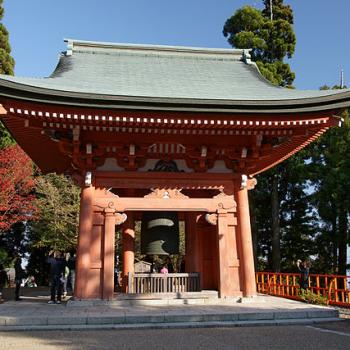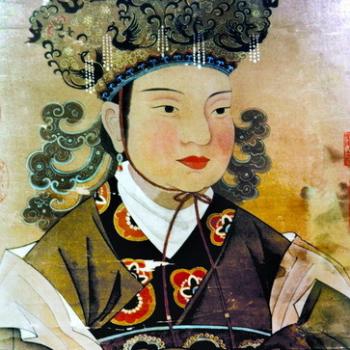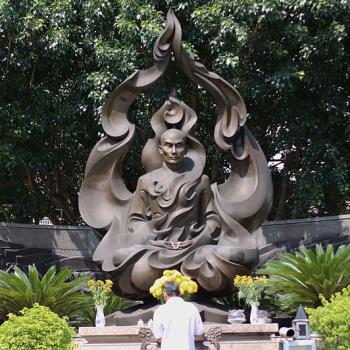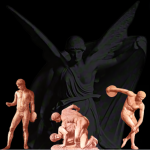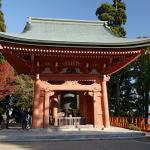There are multiple views about “original Buddhism.” The historical Buddha lived, we believe, about 26 centuries ago. He lived in what is now northeastern India, and in time his disciples spread his teachings throughout tine Indus Peninsula and beyond. Today, Buddhism is a global religion made up of many schools, denominations, sects, sub-sects, or whatever you want to call them. And these can be very different from one another, in doctrine and practice. So it’s natural to wonder how much any of them resemble the Buddhism of 26 centuries ago.
Today the many schools of Buddhism are grouped under three major headings. Theravada Buddhism is the dominant form in Sri Lanka, Myanmar, Laos, Thailand, and Cambodia. Mahayana dominates east Asia — China, Korea, Taiwan, Japan. Vietnam is mostly Mahayana but has some Theravada also. Mahayana Buddhism contains several different sects and denominations, including Zen and Pure Land. The third major heading is Vajrayana, which is the tradition that takes in the several schools of Tibetan Buddhism and a few sects outside Tibet, such as Japanese Shingon. Vajrayana is built upon the same doctrinal and philosophical schools as Mahayana but has its own unique practices.
Original Buddhism? About Theravada
The Theravada Buddhism of southeast Asia is the oldest extant school, and Theravadins often claim their school is original Buddhism. But that’s not something we can know, especially since the historical record is a tad flimsy. The standard story is that about 380 BCE, roughly a century after the Buddha had passed into final Nirvana, a dispute over monastic rules caused Buddhism to split into two major factions. These factions were called the Sthavira (“the Elders”) and the Mahasamghika (“Great Congregation”). Which of these two was closest to an “original Buddhism” would be an entirely subjective opinion at this point. Before long these major schools had further subdivided into sub-schools, many of which disagreed with the others on points of doctrine. The identity and teachings of these schools, and how they relate to each other, is debated by scholars today. As I said, the historical record is a tad flimsy.
Today’s Theravada is associated with Sthavira, but how direct that association is, is hard to say. At least one source I have at hand (John S. Strong, Buddhisms: An Introduction) suggests that Theravada evolved from a sub-school called Vibhajyavada, “those who make distinctions.” Very likely it was Vibhajyavada monastics who brought Buddhism to Sri Lanka during the reign of Ashoka in the 3rd century BCE. The Buddhism of Sri Lanka evolved into today’s Theravada. How much Vibhajyavada resembled “original” Buddhism is not something we can know precisely. For that matter, how much today’s Theravada resembles the Vibhajyavada of the 3rd century BCE is not all that clear, either. It’s certainly possible that today’s Theravada is very close to original Buddhism, but that’s something one must accept on faith.
The Pali Canon, said to preserve the sermons, monastic rules, and other commentary of the historical Buddha, is the scriptural canon of Theravada Buddhism. But other early schools also preserved these same texts, in different prakrits or dialects of Sanskrit, and what we have of those scriptures don’t precisely match. And we have no way to know which version of anything is closest to an “original.” I’ve written about this in an earlier post; see “Will Ancient Gandharan Scrolls Change Buddhist History?” That said, all versions of the early scriptures are said to be remarkably consistent in their presentation of the core teachings of Buddhism. We can be reasonably certain that the main doctrinal principles taught by the Buddha have not been lost, even though the way those principles are understood from school to school does vary somewhat.
The Other Buddhism: Mahayana
Mahayana is sometimes said to have developed from Mahasamghika, although that doesn’t seem to be a universally accepted opinion among academic scholars. I understand today’s Mahayana probably does contain traces of Mahasamghika as well as of some now-extinct Sthavira sects. There are, unfortunately, some big holes in our knowledge of precisely what Mahasamghika taught and how it might have differed doctrinally from Sthavira.
Whatever its origins, Mahayana as we know it today began to emerge about the 1st century BCE and continued to develop through the next few centuries. The distinctive philosophies and doctrines of Mahayana flow from the historical Buddha’s teachings but go beyond what is taught in Theravada. Mahayana doesn’t believe that it has deviated from the Buddha’s original teachings; rather, Mahayana teaches it has clarified them and enlarged upon them.
The “new” philosophies that emerged in Mahayana are explained as turnings of the Dharma Wheel. The first turning was the historical Buddha’s first sermon, where he explained the doctrine of the Four Noble Truths and some other foundational teachings that are shared with Theravada. Subsequent turnings introduced Mahayana teachings on, for example, the fundamental nature of all phenomena and beings and the relationship between mind and our experience of reality.
The Next Few Centuries
The third “yana” or vehicle, Vajrayana, first emerged in northern India in about the 5th century CE. It took root in Tibet in the 7th and 8th centuries, and from Tibet spread throughout the Himalayas. There also was a Vajrayana school in China for some time that is now extinct in China but survives in Japan as Shingon. Vajrayana is also Mahayana; it shares the same philosophical and doctrinal foundations as Mahayana. The difference between Vajrayana and Mahayana is more about practice than doctrine.
Buddhism spread throughout Asia and adapted to many different cultures. Unlike the spread of Christianity in Europe, there was no Buddhist “Pope” or other authority insisting on uniformity. A monk or nun who was ready to teach would simply go somewhere and begin teaching. Early Buddhism was primarily monastic, but in time there were traditions such as Pure Land that became popular with laypeople. And now the many widely diverse traditions are establishing themselves in the West. If the past is any guide in time they will adapt to western culture.
Regarding original Buddhism — I am a Zen student, and so my perspectives tend to align with Mahayana. But I’ve studied the various sects over a period of years. I can’t vouch for the authenticity of every teacher and temple, but in my experience the major denominations at their core are all still teaching the main doctrinal principles of the Buddha. Maybe they’re all “original.”
In a future post I want to look at “original Buddhism” from the perspective of the West, which in some ways is an entirely different issue.
.





